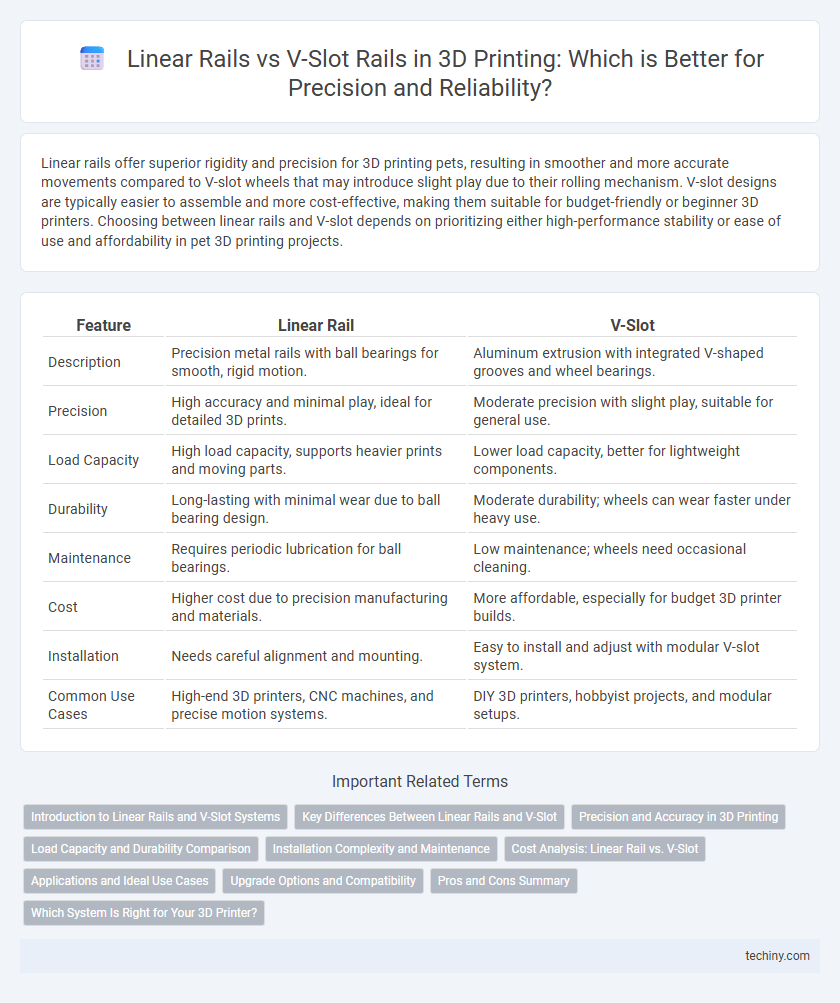Linear rails offer superior rigidity and precision for 3D printing pets, resulting in smoother and more accurate movements compared to V-slot wheels that may introduce slight play due to their rolling mechanism. V-slot designs are typically easier to assemble and more cost-effective, making them suitable for budget-friendly or beginner 3D printers. Choosing between linear rails and V-slot depends on prioritizing either high-performance stability or ease of use and affordability in pet 3D printing projects.
Table of Comparison
| Feature | Linear Rail | V-Slot |
|---|---|---|
| Description | Precision metal rails with ball bearings for smooth, rigid motion. | Aluminum extrusion with integrated V-shaped grooves and wheel bearings. |
| Precision | High accuracy and minimal play, ideal for detailed 3D prints. | Moderate precision with slight play, suitable for general use. |
| Load Capacity | High load capacity, supports heavier prints and moving parts. | Lower load capacity, better for lightweight components. |
| Durability | Long-lasting with minimal wear due to ball bearing design. | Moderate durability; wheels can wear faster under heavy use. |
| Maintenance | Requires periodic lubrication for ball bearings. | Low maintenance; wheels need occasional cleaning. |
| Cost | Higher cost due to precision manufacturing and materials. | More affordable, especially for budget 3D printer builds. |
| Installation | Needs careful alignment and mounting. | Easy to install and adjust with modular V-slot system. |
| Common Use Cases | High-end 3D printers, CNC machines, and precise motion systems. | DIY 3D printers, hobbyist projects, and modular setups. |
Introduction to Linear Rails and V-Slot Systems
Linear rails and V-slot systems are essential components in 3D printer motion mechanisms, providing precise linear movement and stability. Linear rails feature hardened steel rails and matching sliders for high rigidity and accuracy, ideal for professional-grade 3D printers requiring smooth, vibration-free operation. V-slot systems utilize aluminum extrusions with V-shaped grooves and compatible wheels, offering a cost-effective, easy-to-assemble solution with adequate precision for hobbyist and mid-range 3D printing applications.
Key Differences Between Linear Rails and V-Slot
Linear rails offer superior rigidity and precision due to their metal construction and recirculating ball bearings, making them ideal for high-accuracy 3D printing applications. V-slot wheels run on aluminum profiles, providing easier installation and cost-effectiveness but with slightly less load capacity and precision. The choice between linear rails and V-slot primarily impacts print quality, machine durability, and maintenance requirements in 3D printer builds.
Precision and Accuracy in 3D Printing
Linear rails provide superior precision and accuracy in 3D printing due to their rigid design and minimal play, enabling smoother and more consistent motion control. V-slot wheels offer easier installation and lower cost but can introduce slight wobble and wear over time, potentially reducing dimensional accuracy. For high-precision 3D printing applications, linear rails are preferred to maintain tight tolerances and repeatable print quality.
Load Capacity and Durability Comparison
Linear rails offer significantly higher load capacity and superior durability compared to V-slot profiles, making them ideal for industrial-grade 3D printers requiring precise motion control under heavy loads. V-slot rails, while more cost-effective and easier to install, typically handle lower loads and exhibit faster wear over time due to their aluminum construction and wheel-based movement system. Choosing linear rails enhances print accuracy and longevity, especially in applications with continuous high-speed operation and substantial torque.
Installation Complexity and Maintenance
Linear rails offer precise motion control with a straightforward installation process requiring exact alignment and secure mounting, minimizing play and vibrations for high-accuracy 3D printing. V-slot wheels provide easier installation with a more forgiving setup, using V-shaped aluminum extrusions that allow quick assembly and adjustments but may require regular wheel replacement and cleaning to prevent wear and maintain smooth motion. Maintenance on linear rails involves periodic lubrication and inspection to avoid debris accumulation, while V-slot systems demand more frequent attention to wheel condition and extrusion cleanliness to ensure consistent performance.
Cost Analysis: Linear Rail vs. V-Slot
Linear rails generally incur higher upfront costs due to precision manufacturing and durable materials, making them a premium choice for 3D printer motion systems. V-slot aluminum extrusions offer a more budget-friendly option, combining integrated wheel-based guidance with moderate durability and ease of assembly. Analyzing total cost of ownership, linear rails may reduce long-term maintenance expenses, while V-slot systems excel in affordability and customization flexibility for hobbyist and small-scale printers.
Applications and Ideal Use Cases
Linear rails provide high precision and rigidity, making them ideal for industrial-grade 3D printers and CNC machines requiring smooth, accurate motion under heavy loads. V-slot wheels offer ease of assembly and flexibility, suited for hobbyist printers and smaller-scale projects where cost-effectiveness and modularity are prioritized. Applications demanding maximum durability and minimal maintenance benefit from linear rails, while V-slot excels in customizable, lightweight setups.
Upgrade Options and Compatibility
Linear rails offer superior rigidity and precision for 3D printer upgrades, enhancing print quality and repeatability over V-slot wheels. V-slot systems are widely compatible with various frame materials and easier to install, making them ideal for budget-friendly or modular upgrades. Choosing between linear rails and V-slot depends on the desired balance of high-performance accuracy versus cost-effective compatibility.
Pros and Cons Summary
Linear rails offer high precision and load capacity, ideal for heavy-duty 3D printing tasks but come at a higher cost and require precise alignment, increasing installation complexity. V-slot wheels provide smoother motion with quieter operation and easier assembly, making them cost-effective for most desktop 3D printers, though they may suffer from wear and less rigidity over time. Both systems impact print quality and maintenance, with the choice depending on specific project requirements and budget constraints.
Which System Is Right for Your 3D Printer?
Linear rails offer superior precision and rigidity, making them ideal for high-accuracy 3D printers requiring minimal deflection and smooth motion. V-slot systems provide a cost-effective, easier-to-install alternative with decent durability and versatility for hobbyist or mid-range printers. Choose linear rails for enhanced performance in complex prints, while V-slot suits budget-conscious users prioritizing simplicity and flexibility.
Linear rail vs V-slot Infographic

 techiny.com
techiny.com